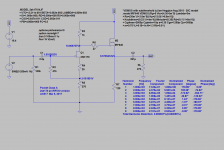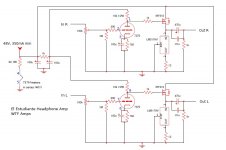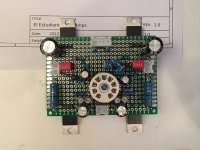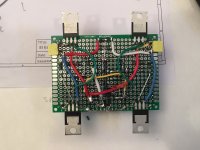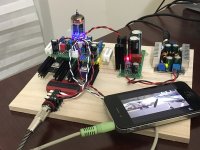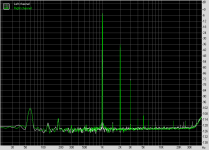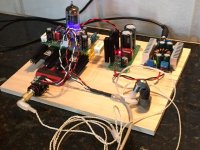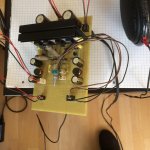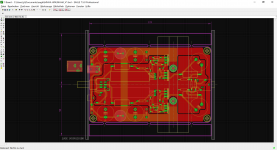

Inspired by Pete Millett's Starving Student, complete with 48V wall wart and odd-ball tube. The old 19J6 Starving Student was the first amp I ever wired from a schematic point to point, but the tubes have been going up in price so I thought a variation on the theme might be helpful for the newbies.
Sounds very good on my low impedance headphones.
Lengthier write up here with BoM, etc.
edit: Here's the 7370 datasheet. I used 5687 curves to derive a bias point. It is right at 24V on the anode with the values shown.
Last edited:
Ok, so I finally got around to building the Estudiante amp. The 7370 tube and schematics were courtesy Sodacose. Here is the updated schematic with tube pinout numbers for tube newbies like me:
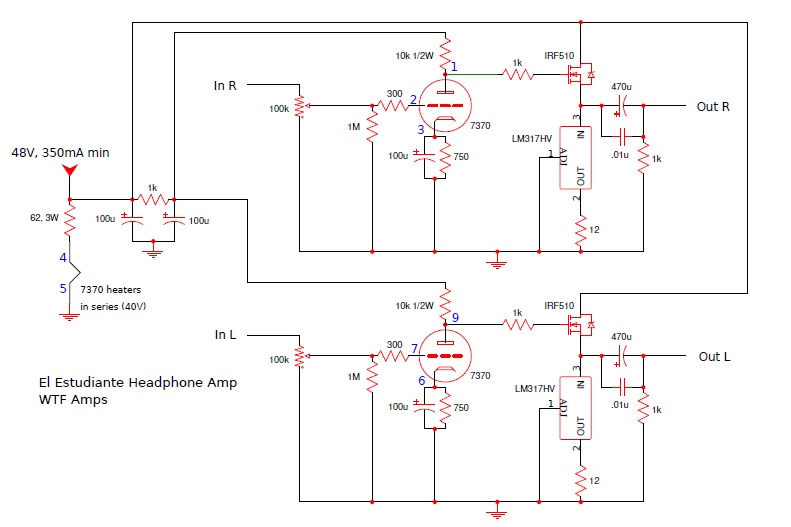
I tried using a regular LM317T (not the HV) and had problems getting it to work. So as a temporary measure, I am using a 270R 5W wirewound cement resistor. I am using a 12v 3A SMPS wallwart to power a DC-DC step up to 50v, then using a Juma Easypeasy cap multiplier with an IRF610 followed by a couple of 1000uF 100v caps, I feed the amp with 45v of pretty clean hum-free power.
I am using IRF610's in place of the specified IRF510's, and I added 1uF 63v Wima MKS input coupling caps. I also added 680pF 100v MKT caps on the input tied to ground for RF filtering. I also added a 10R ground lift resistor to the signal ground relative to power ground. On the output, I am using a cheap Chinese 470uF 50v cap - ESR measured at 60mOhm, bypassed with a cheap yellow boxcap 100nF 100v MKT. Two 4.7k 1W carbon resistors in series form the "10k" specified on the anode. On the cathode, I have 680R+68R=748R (close enough to specified 750R). Had the LM317T worked, two 22R 2W metal film resistors in parallel form 11R vs the recommended 12R. For the filament, qnty 3 x 22R 2W in series form the 66R vs specified 62R. I stuck a 9pin tube socket at the middle of a 6cm x 8cm veroboard and placed a 4pin JST jack for the headphone outs, dual 2 pin JST jacks for left and right audio input, and a 2 pin JST jack at the middle bottom for the 48v Vcc in. I love JST 2.5mm pitch PCB connectors/jacks. Now that I have the crimper, I use them everywhere: reliable, compact footprint, cheap. Plus, the ability to disconnect easily is key when debugging. Here is top side:
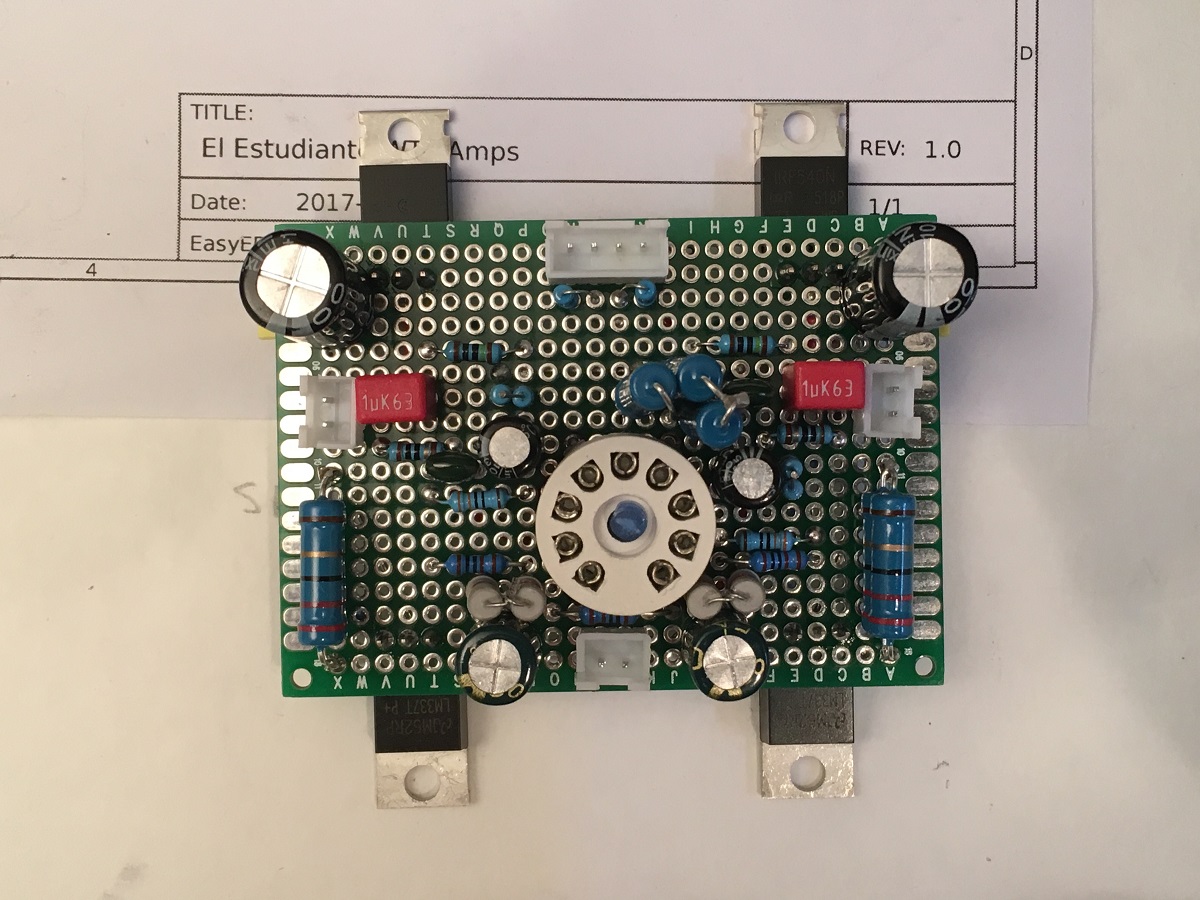
Here is the bottom side - P2P bottom sides are always fugly. I added a little LED under the tube for an on-indicator (not realizing the orange heater glow is pretty good for that):
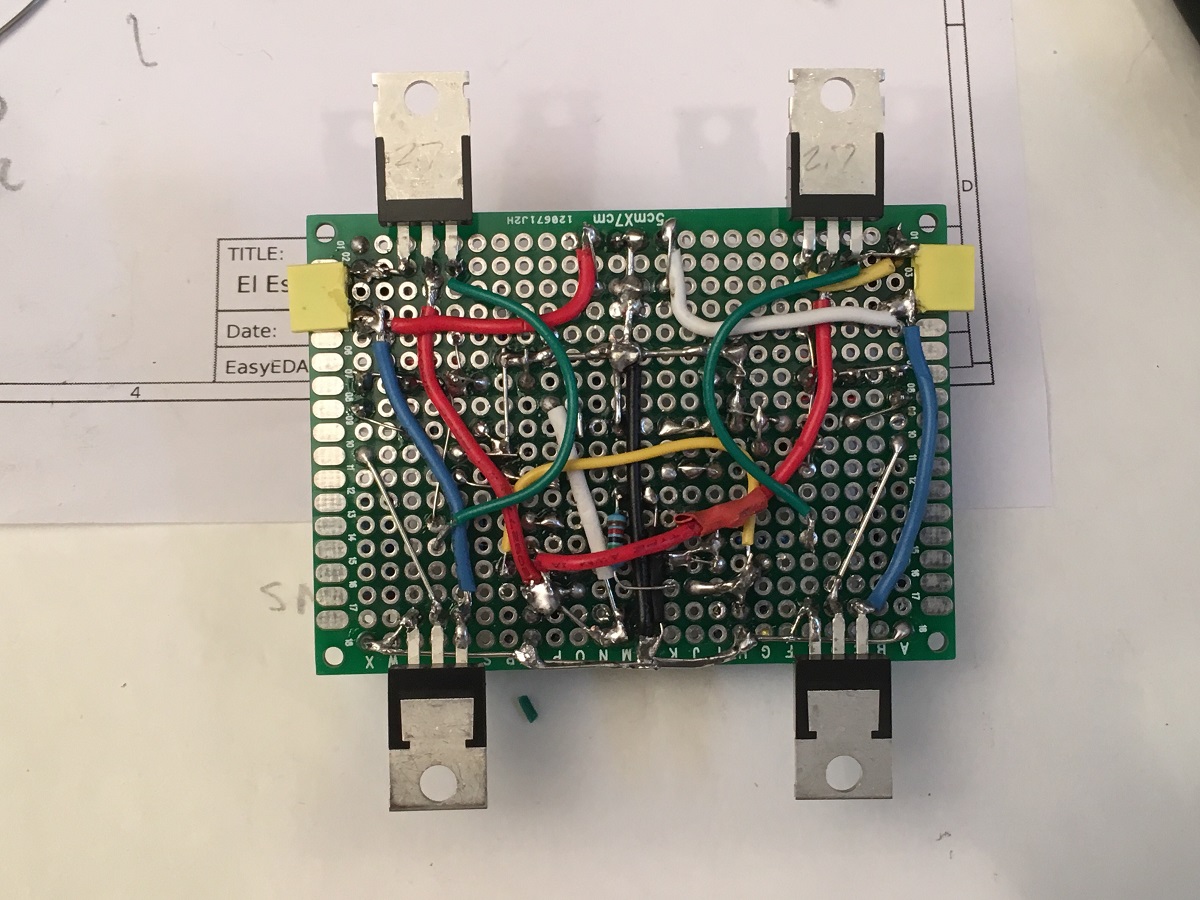
Here is the amp with PSU and Cap Mx mounted on a plank to make it transportable. I'll probably put this in a small project box at some point:
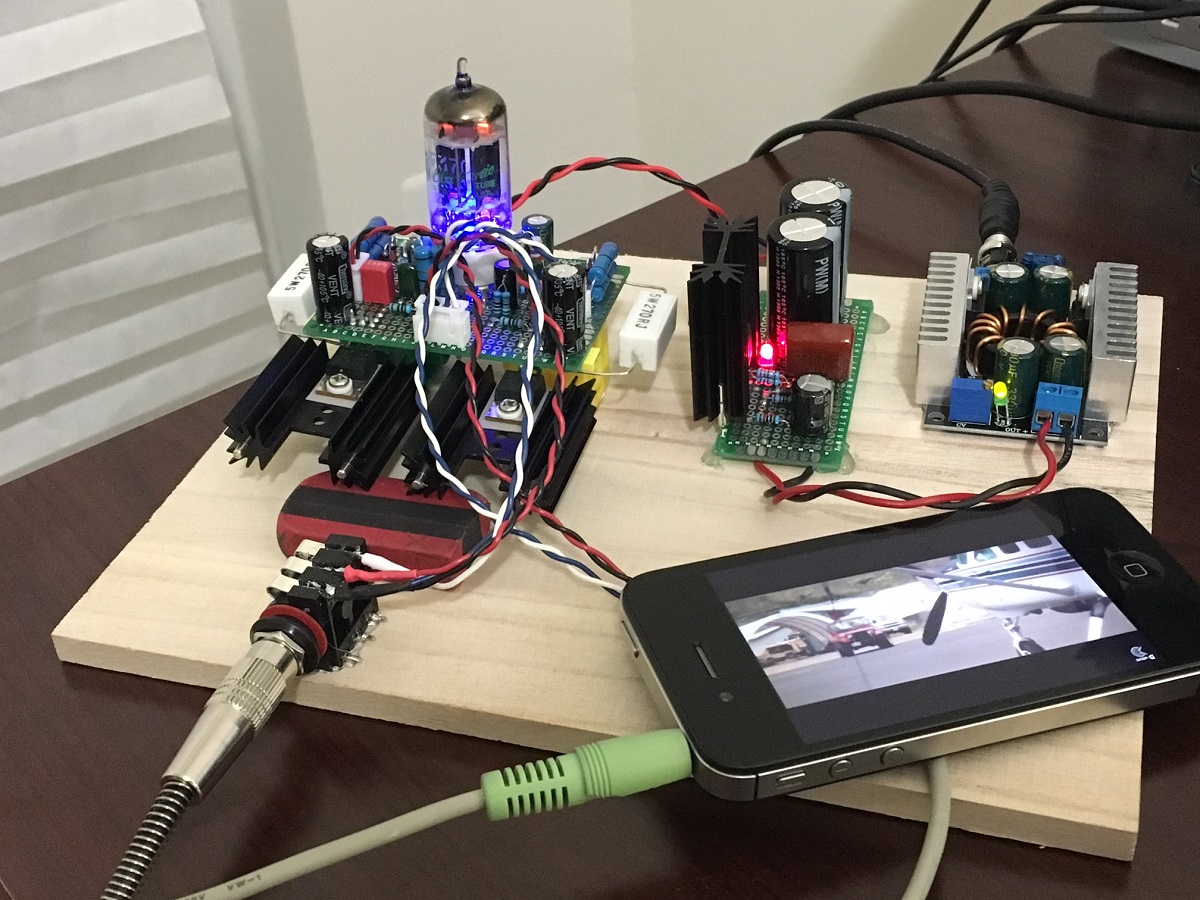
It sounds great - really lively, full bodied sound. Gets quite loud too and can drive some serious SPL into my OB-1's, and certainly, can get the DT880's loud too but not as loud as the OB-1's. Overall, the sound is very nice, typical of zero global feedback SE Class A amps. The tube definitely gives the sound some character. The soundstage is very open and wide. The amp is silent - no audible noise, hiss, or hum when source is off. Overall, a very easy to build amp, with superb sound. I really enjoy it and highly recommend this project.
For those of you interested in measurements, here is the FFT driving the built-in 1k cap bleed-off resistors at 700mV p-p. Noise floor is really nice and clean at -126dB. There is a realtively high circa 2% THD, but all of it is second harmonic. I think it will go down some with a proper CCS when I have the LM317HV's in place, plus a higher bias will help as I am running 89mA bias at present vs the 125mA specified. So the 2% is typical of SE Class A tube amps, I am told. So it is all good - and the warm sound is very lovely and great with many genre's. Jazz, pop, classic rock, trance, deep house, hip hop, almost anything.
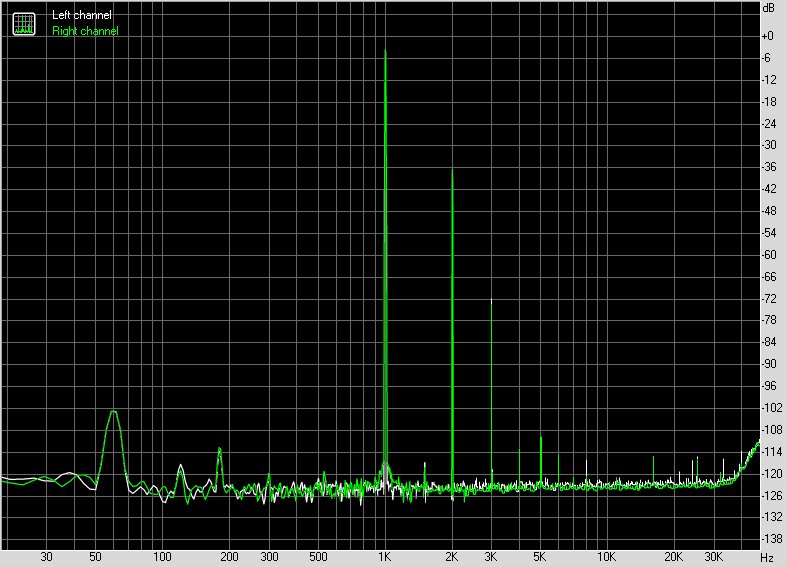
I tried using a regular LM317T (not the HV) and had problems getting it to work. So as a temporary measure, I am using a 270R 5W wirewound cement resistor. I am using a 12v 3A SMPS wallwart to power a DC-DC step up to 50v, then using a Juma Easypeasy cap multiplier with an IRF610 followed by a couple of 1000uF 100v caps, I feed the amp with 45v of pretty clean hum-free power.
I am using IRF610's in place of the specified IRF510's, and I added 1uF 63v Wima MKS input coupling caps. I also added 680pF 100v MKT caps on the input tied to ground for RF filtering. I also added a 10R ground lift resistor to the signal ground relative to power ground. On the output, I am using a cheap Chinese 470uF 50v cap - ESR measured at 60mOhm, bypassed with a cheap yellow boxcap 100nF 100v MKT. Two 4.7k 1W carbon resistors in series form the "10k" specified on the anode. On the cathode, I have 680R+68R=748R (close enough to specified 750R). Had the LM317T worked, two 22R 2W metal film resistors in parallel form 11R vs the recommended 12R. For the filament, qnty 3 x 22R 2W in series form the 66R vs specified 62R. I stuck a 9pin tube socket at the middle of a 6cm x 8cm veroboard and placed a 4pin JST jack for the headphone outs, dual 2 pin JST jacks for left and right audio input, and a 2 pin JST jack at the middle bottom for the 48v Vcc in. I love JST 2.5mm pitch PCB connectors/jacks. Now that I have the crimper, I use them everywhere: reliable, compact footprint, cheap. Plus, the ability to disconnect easily is key when debugging. Here is top side:
Here is the bottom side - P2P bottom sides are always fugly. I added a little LED under the tube for an on-indicator (not realizing the orange heater glow is pretty good for that):
Here is the amp with PSU and Cap Mx mounted on a plank to make it transportable. I'll probably put this in a small project box at some point:
It sounds great - really lively, full bodied sound. Gets quite loud too and can drive some serious SPL into my OB-1's, and certainly, can get the DT880's loud too but not as loud as the OB-1's. Overall, the sound is very nice, typical of zero global feedback SE Class A amps. The tube definitely gives the sound some character. The soundstage is very open and wide. The amp is silent - no audible noise, hiss, or hum when source is off. Overall, a very easy to build amp, with superb sound. I really enjoy it and highly recommend this project.
For those of you interested in measurements, here is the FFT driving the built-in 1k cap bleed-off resistors at 700mV p-p. Noise floor is really nice and clean at -126dB. There is a realtively high circa 2% THD, but all of it is second harmonic. I think it will go down some with a proper CCS when I have the LM317HV's in place, plus a higher bias will help as I am running 89mA bias at present vs the 125mA specified. So the 2% is typical of SE Class A tube amps, I am told. So it is all good - and the warm sound is very lovely and great with many genre's. Jazz, pop, classic rock, trance, deep house, hip hop, almost anything.
Attachments
Last edited:
Wow, very detailed notes on your build. Looks great!
FWIW, I changed the bom to specify the HV version of lm317 for now. If yours work when you get them, I think we can say the non HV parts will be unreliable. I know a couple people had them working but there was another builder that did have some similar issues.
FWIW, I changed the bom to specify the HV version of lm317 for now. If yours work when you get them, I think we can say the non HV parts will be unreliable. I know a couple people had them working but there was another builder that did have some similar issues.
I am listening to it with some KZ ZS5 with silver braided cables 16ohm IEM's (4 driver - 2 balanced armature + 2 dynamic drivers). These are 106dB sensitive so don't take much drive but sound is very nice. Full rich bass even on 470uF output caps. These phones are very sensitive so I can detect a very faint level of hiss which I suspect may be the actual hiss from the source opamp (iPhone 6s). Barely audible so no big deal. Interesting difference with solid state amp is that this amp has microphonics. It picks up sounds and vibrations fromohysically touching it. Sounds like a ringing dull bell. If I hold the tube with pressure - the ringing is reduced so I suspect it comes from the tube. I don't hear any of his in the solid state PCA by contrast.
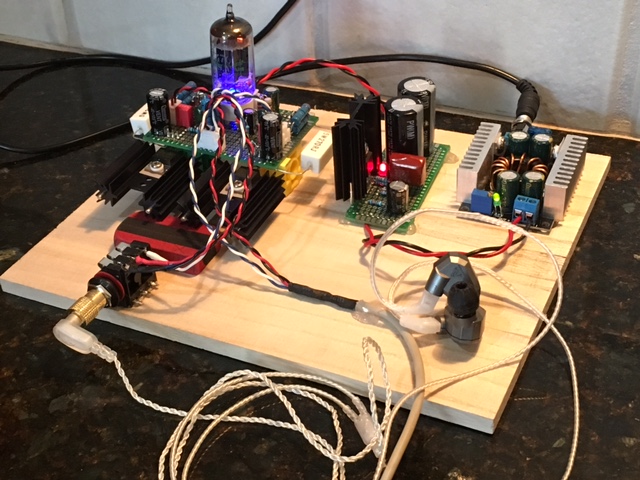
One question I have is why this amp is so sensitive to noise from jostling of the 3.5mm input jack from the source. Very loud scratchy noises vs nothing at all in the PCA? Is it some sort of grounding scheme that is amiss?
One question I have is why this amp is so sensitive to noise from jostling of the 3.5mm input jack from the source. Very loud scratchy noises vs nothing at all in the PCA? Is it some sort of grounding scheme that is amiss?
Attachments
Last edited:
I can't comment on the 3.5mm jack as I built mine with rca inputs and haven't had any issues. You are using input caps though and there may be an issue with the DC reference on the input. I'd try a high value resistor between signal and ground.
Microphonics might be eliminated with a new tube. I've had tubes that let me hear the turning of volume pots before (fixed with a fresh tube). Just a luck of the draw with tubes sometimes. If it isn't a constant ringing or background noise, I'd leave it be. Or stick some tube dampers on it if you want to dress it up
Microphonics might be eliminated with a new tube. I've had tubes that let me hear the turning of volume pots before (fixed with a fresh tube). Just a luck of the draw with tubes sometimes. If it isn't a constant ringing or background noise, I'd leave it be. Or stick some tube dampers on it if you want to dress it up
So there is no need for input caps then? It does sound like some sort of ground reference issue. Also, I added a 10R ground lift on signal ground relative to power ground and wonder if that's the culprit? I ordered some new tubes already. They are pretty economical actually. Some GE MIL-Spec ones for $7 for set of 3.
As long as whatever is feeding the amp has output caps, you shouldn't need input caps. The input is at ground potential (grid of tube is referenced to ground).
How do you have the 10 ohm resistor configured? In ground return from tube/mosfets? If so, my concern would be that you'd be losing a couple precious volts. I did not find such a resistor necessary in my amp.
The GE are the only 7370s I've been using and seem to be the most common brand. And yes, they are cheap! You can pick up a sleeve of 5 for less than the price of a new 12au7.
How do you have the 10 ohm resistor configured? In ground return from tube/mosfets? If so, my concern would be that you'd be losing a couple precious volts. I did not find such a resistor necessary in my amp.
The GE are the only 7370s I've been using and seem to be the most common brand. And yes, they are cheap! You can pick up a sleeve of 5 for less than the price of a new 12au7.
Hi,
Yes, you need a DC reference to common ground that doesn't change DC resistance. Using a series capacitor and a high value resistor (100K or so will be fine) to ground should settle that down. Otherwise every tiny change with the resistance will create noise in the tube.
For microphonics, which sounds like your noise problem when physically causing vibrations, a new tube might solve. Or, a new tube could be worse also. Luck of the draw. If you do want a quiet tube, rewire the socket for a 12AU7 and try the Electroharmonix version. I have found these to be very good overall, and they are not prone to excessive microphonics.
-Chris
Yes, you need a DC reference to common ground that doesn't change DC resistance. Using a series capacitor and a high value resistor (100K or so will be fine) to ground should settle that down. Otherwise every tiny change with the resistance will create noise in the tube.
For microphonics, which sounds like your noise problem when physically causing vibrations, a new tube might solve. Or, a new tube could be worse also. Luck of the draw. If you do want a quiet tube, rewire the socket for a 12AU7 and try the Electroharmonix version. I have found these to be very good overall, and they are not prone to excessive microphonics.
-Chris
It's that opaque ampule shape in the middle. Two Raytheon compact tubes. Probably used on 1960's jet fighters. 
NIB Raytheon USA 1AD4 Vacuum Tube Subminiature | VIVA TUBES | Reverb
@JPS: nice work! You are a person who appreciates PCB connectors, I like that. One question is why your vol pot is in middle of board rather than on the edge - how do you adjust the knob?
NIB Raytheon USA 1AD4 Vacuum Tube Subminiature | VIVA TUBES | Reverb
@JPS: nice work! You are a person who appreciates PCB connectors, I like that. One question is why your vol pot is in middle of board rather than on the edge - how do you adjust the knob?
One question is why your vol pot is in middle of board rather than on the edge - how do you adjust the knob?
Don't you guess he uses his fingers to turn the volume pot's shaft?
He doesn't have a knob on the shaft.
Nah...., this is strictly proto for purposes of listening sound check - he put the pot in the middle to keep wires short. Do you see the 3.5mm and power jacks? The exit out the bottom side of the PCB so doesn't make sense for shaft to have knob at 90deg to jacks. JPS makes nice layouts for real boxes so now that the sound check is good, a real PCB will be forthcoming is my guess
I´ve fairy fingers!
But PCB existing, I´m never starting breadboard before PCB routing finished.
I need to find time for measurements. Listening not bad with high impedance headphones (HD600, DT880 600R), lets say more bass as Wayne´s HPA supplied with +/-18VDC?!
Meanwell performed not as expected: linear laboratory supply much better.
CCS LM334 improuving (don´t know, 10M45, BJT, JFET or Ale´s one); adding K-Multiplier? +Ub increases up to +48VDC (COTS wall cube existing)? heatsink changes for better TO220 mounting skills.
Definitively no microphonics and for 30€ not bad at all
JP
But PCB existing, I´m never starting breadboard before PCB routing finished.
I need to find time for measurements. Listening not bad with high impedance headphones (HD600, DT880 600R), lets say more bass as Wayne´s HPA supplied with +/-18VDC?!
Meanwell performed not as expected: linear laboratory supply much better.
CCS LM334 improuving (don´t know, 10M45, BJT, JFET or Ale´s one); adding K-Multiplier? +Ub increases up to +48VDC (COTS wall cube existing)? heatsink changes for better TO220 mounting skills.
Definitively no microphonics and for 30€ not bad at all
JP
Attachments
Nah...., this is strictly proto for purposes of listening sound check - he put the pot in the middle to keep wires short.
If you already knew the answer, then why ask? Obviously, no one wants long wires(or traces) running from the volume pot to the amplifier.
Should he design a board and post the Gerber files, I'm sure you'll be the FIRST to send the Gerbers to a Chinese board house and get some boards made so you don't have to do any of the work!.
Sweeeet!
- Status
- This old topic is closed. If you want to reopen this topic, contact a moderator using the "Report Post" button.
- Home
- Amplifiers
- Headphone Systems
- "Estudiante" Hybrid (7370 + MOSFET)
